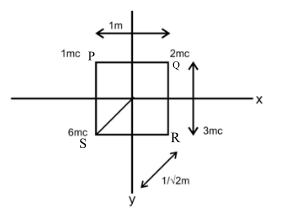
Four charges
(A) The electric potential at origin.
(B) The electric potential is zero everywhere along the X axis.
(C) The electric potential is not zero along the Z-axis.
(D) The electric potential is zero along the Z-axis for any orientation of the square in
Answer
485.1k+ views
Hint
In this question, first draw the diagram to represent the given square and the charges at its corner and then calculate the electric potential at the center of the square due to charge at the corner of the square.
Complete step by step answer
In this question, the concept of the electric potential will be used, that is it depends on the quantity of charge and the distance between the point and the charge. We must calculate the potential due to the given charges. So, let us assume that the square is PQRS and charges are placed at the respective corners as shown in figure below.

We have to find the effective potential due to the charges present at the corners of the square. We know that the potential at distance
Here,
As we know that the potential due to charges is given as algebraic sum as the potential is scalar quantity as
Here, the charges at corner
Now we substitute the given values in the above expression as,
Now, we solve the above expression to obtain,
Since, all the points are equidistant, and the magnitude of the charge is positive so the potential will be non-zero.
After solving the above two equations we get a non-zero potential at origin which is equidistant from the charges and if you look into the image the axis passing through this is
Therefore, the correct option is (C).
Note
The electric potential at the origin will be zero if the charges at the corner of the diagonals of the square are of same magnitude but opposite sign of charges. The electric potential is a scalar quantity and the electric field is a vector quantity.
In this question, first draw the diagram to represent the given square and the charges at its corner and then calculate the electric potential at the center of the square due to charge at the corner of the square.
Complete step by step answer
In this question, the concept of the electric potential will be used, that is it depends on the quantity of charge and the distance between the point and the charge. We must calculate the potential due to the given charges. So, let us assume that the square is PQRS and charges are placed at the respective corners as shown in figure below.

We have to find the effective potential due to the charges present at the corners of the square. We know that the potential at distance
Here,
As we know that the potential due to charges is given as algebraic sum as the potential is scalar quantity as
Here, the charges at corner
Now we substitute the given values in the above expression as,
Now, we solve the above expression to obtain,
Since, all the points are equidistant, and the magnitude of the charge is positive so the potential will be non-zero.
After solving the above two equations we get a non-zero potential at origin which is equidistant from the charges and if you look into the image the axis passing through this is
Therefore, the correct option is (C).
Note
The electric potential at the origin will be zero if the charges at the corner of the diagonals of the square are of same magnitude but opposite sign of charges. The electric potential is a scalar quantity and the electric field is a vector quantity.
Recently Updated Pages
Master Class 12 Business Studies: Engaging Questions & Answers for Success

Master Class 12 English: Engaging Questions & Answers for Success

Master Class 12 Social Science: Engaging Questions & Answers for Success

Master Class 12 Chemistry: Engaging Questions & Answers for Success

Class 12 Question and Answer - Your Ultimate Solutions Guide

Master Class 12 Economics: Engaging Questions & Answers for Success

Trending doubts
Give 10 examples of unisexual and bisexual flowers

Draw a labelled sketch of the human eye class 12 physics CBSE

Differentiate between homogeneous and heterogeneous class 12 chemistry CBSE

Write a short note on Franklands reaction class 12 chemistry CBSE

Differentiate between insitu conservation and exsitu class 12 biology CBSE

What are the major means of transport Explain each class 12 social science CBSE




